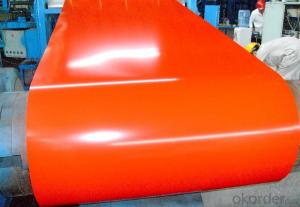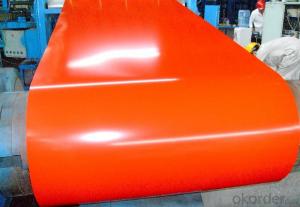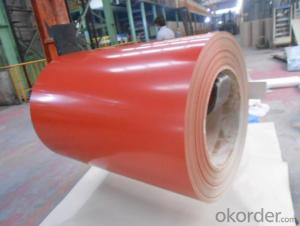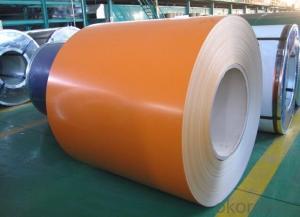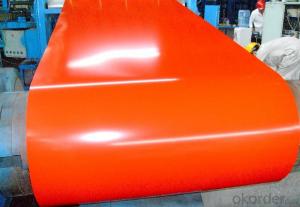Orange Color Pre-Painted Galvanized/Aluzinc Steel Sheet in Coils
- Loading Port:
- Shanghai
- Payment Terms:
- TT OR LC
- Min Order Qty:
- 50 m.t.
- Supply Capability:
- 5000 m.t./month
OKorder Service Pledge
OKorder Financial Service
You Might Also Like
1. Pre-Painted Galvanized/Aluzinc Steel Coil Description:
With GI as base material, after pretreatment (degrease and chemical treatment ) and liquid dope with several layers of color, then after firing and cooling, finally the plate steel is called pre-painted galvanized (aluzinc) steel. Pre-painted galvanized steel is good capable of decoration, molding, corrosion resistance. It generally displays superior workability, durability and weather resistance.
2.Main Features of the Pre-Painted Galvanized/Aluzinc Steel Coil:
• Excellent process capability
• Smooth and flat surface
• Workability, durability
• Excellent heat resistance performance
• High strength
• Good formability
• Good visual effect
3.Pre-Painted Galvanized/Aluzinc Steel Coil Images
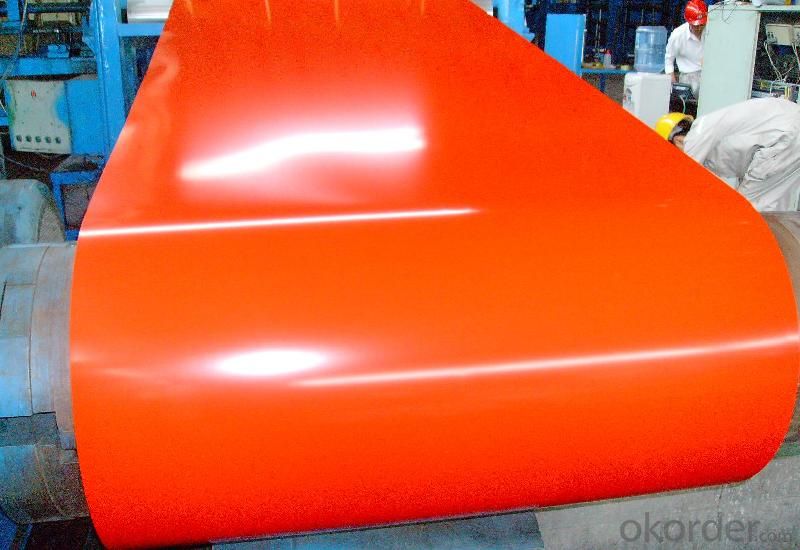
4.Pre-Painted Galvanized/Aluzinc Steel Coil Specification
Standard: AISI, ASTM, BS, DIN, GB, JIS
Grade: DX51D, DX52D
Thickness: 0.17-2.0mm
Brand Name: KMRLON
Model Number: coil
Type: Steel Coil
Technique: Cold Rolled
Surface Treatment: Coated
Application: Boiler Plate
Special Use: High-strength Steel Plate
Width: 20-1250mm
Length: customized
commoidty: pre-painted galvanized steel coil
Thickness: 0.13-4.0mm
width: 20-1250mm
zinc coating: 40-180g/m2
printing thickness: top side: 20+/-5 microns, back side: 5-7 microns
color: all RAL color
surface treatment: color coated
coil weight: 4-7 tons
coil ID: 508/610mm
packaging: standard seaworthy packing
5.FAQ of Pre-Painted Galvanized/Aluzinc Steel Coil
1. What’s the application of this product?
Roof, roof structure, surface sheet of balcony, frame of window, etc.
2. What’s the brand of the paint?
We use the best brand of all of the word—AKZO.
3. How about your company?
A world class manufacturer & supplier of castings forging in carbon steel and alloy steel,is one of the large-scale professional investment casting production bases in China,consisting of both casting foundry forging and machining factory. Annually more than 8000 tons Precision casting and forging parts are exported to markets in Europe,America and Japan. OEM casting and forging service available according to customer’s requirements.
4. How to guarantee the quality of the products?
We have established the international advanced quality management system,every link from raw material to final product we have strict quality test;We resolutely put an end to unqualified products flowing into the market. At the same time, we will provide necessary follow-up service assurance.
5. How long can we receive the product after purchase?
Usually within thirty working days after receiving buyer’s advance payment or LC. We will arrange the factory manufacturing as soon as possible. The cargo readiness usually takes 15-25 days, but the shipment will depend on the vessel situation.
- Q: What are the different types of steel coils available?
- There exists a variety of steel coils, each possessing distinct characteristics and uses. 1. Hot Rolled Steel Coils: These coils undergo production at high temperatures and are ideal for applications requiring a sleek and polished finish, such as automotive components, construction materials, and machinery. 2. Cold Rolled Steel Coils: In order to enhance surface finish and dimensional accuracy, these coils are processed at lower temperatures. They find extensive use in industries like automotive, appliances, and electronics, where precision is of utmost importance. 3. Galvanized Steel Coils: A layer of zinc is applied to these coils to safeguard the underlying steel against corrosion. They are commonly utilized in the construction sector, roofing, and automotive parts that are exposed to harsh environmental conditions. 4. Stainless Steel Coils: Created by combining iron, chromium, and other elements, these coils offer exceptional resistance to corrosion and possess high strength. They are widely employed in applications demanding hygiene, such as food processing equipment, medical instruments, and kitchen appliances. 5. Electrical Steel Coils: Specifically designed for applications requiring magnetic properties, these coils are utilized in transformers, electric motors, and generators. They exhibit low core losses and high permeability, ensuring efficient transfer of electrical energy. 6. Pre-painted Steel Coils: These coils are coated with paint or other protective coatings to enhance their visual appeal and provide additional protection against corrosion. They are commonly used in the construction industry for cladding, roofing, and siding. 7. Tinplate Steel Coils: A thin layer of tin is applied to these coils to prevent corrosion and act as a barrier against moisture and oxygen. They find widespread usage in the packaging industry for cans, containers, and other food or beverage packaging. These examples merely scratch the surface of the various steel coil options available in the market. Each variant possesses its own unique properties and applications, rendering them suitable for diverse industries and purposes.
- Q: I live in the Black Hills and I need to re-side my cottage. I like the look of vinyl. I've heard pros and cons about both steel and vinyl. Is steel really that easy to dent? It just doesn't look as 'clean' as vinyl. Also what 3 color combos do you like? My cottage has shutters.
- I'd like to know why you need to re-side it. I would get vinyl because it will not need painting as soon as steel.
- Q: How are steel coils used in the production of electrical conduits?
- Several techniques are employed in the production of electrical conduits using steel coils. Firstly, the raw material for manufacturing electrical conduits is steel coils. These coils are composed of specially processed and formed high-quality steel, which is transformed into a continuous strip of considerable length. Once the steel coils are acquired, they are fed into a machine known as a slitter. This machine swiftly slices the coils into narrower strips of the desired width, which will function as the foundational material for the electrical conduits. The subsequent step involves shaping the steel strips into the desired conduit shape. This is accomplished by guiding the strips through a series of rollers and various shaping tools. Gradually, the steel strips take on the round or rectangular shape of the conduit as the rollers exert pressure and manipulate the strip until it reaches the desired form. After the shaping process, the ends of the steel strips are fused together to create a seamless conduit. This welding procedure ensures that the conduit possesses a structure devoid of any seams, a vital characteristic for its functionality and durability. Once the conduits have been shaped and welded, they undergo additional processing to enhance their properties. This may involve galvanizing, whereby a protective layer of zinc is applied to the conduits to shield them from corrosion. This additional layer significantly prolongs the lifespan of the conduits, rendering them suitable for a wide range of electrical applications. In summary, steel coils play a crucial role in the production of electrical conduits. These coils serve as the raw material that is shaped, welded, and further processed to create the final product. The utilization of steel coils ensures that the electrical conduits are robust, long-lasting, and capable of withstanding the rigorous demands of electrical installations.
- Q: What are the surface treatments for steel coils?
- Some common surface treatments for steel coils include galvanizing, painting, and coating. These treatments are applied to protect the steel from corrosion, improve its appearance, and enhance its durability.
- Q: I'm pretty sure that this topic has been beaten to death by now. But, I still can't get a definite answer. With stainless steel, you get better corrosion resistance, and you will hold and edge longer. With carbon steel, you will hold a sharper edge, and you could forge a knife blade longer than 2 ft without breakage. I'm personally a fan of stainless steel ( the 440 grade stuff ), just because it seems to hold up to use and abuse better in the long run. HOWEVER, I have NEVER had a factory made knife break on me. I don't think that they would try to sell you a knife that didn't do what it was meant to do, at least to a reasonable degree. (I work for a living, and can't afford a custom $600 knife.) What do you think? Is this a pointless topic? Will there ever be a winner?
- If your talking about a folding pocket knife, I think that it's basically six one way and a half dozen the other. I actually do prefer stainless for my pocket knives. I don't want to oil a knife to the degree I feel carbon requires, only to then stick it my pocket to attract dirt to the knife and oil to my pants. I'm the exact opposite on sheath knives though. I like 1095 carbon steel, plain edge sheath knives. I'll thrash on them HARD, and I rarely have major edge problems. Of course, I require them to be coated with some kind of powder coat or the like, because they can rust, but I do try and keep them clean and dry when in the sheath, so they won't pit the uncoated edge. My reasons for this sheath knife preference is multi-fold. First, these knives are simply affordable. I don't spend $80 dollars on a outdoors sheath knife. I use the tool too hard to want to spend more. I don't like the more traditional stainless steels such as AUS-8, 420HC, and 440C (not to mention the HORRENDOUS 440A) because I feel that the all else being equal, a stainless blade will bend before a carbon blade will break. I also think that carbon holds an edge at least as well, if not better, than traditional stainless, and it's much easier to hone. I don't know much about these new laminates, other than the very hard, but not so tough. They seem to be POSSIBLY too brittle for my use. That, combined with the fact that they cost a FORTUNE, means that I just won't be considering them.
- Q: so my parents gave me stainless steel cookware for christmas and the first time i used it i cooked chicken. it stuck to the pan and where the oil splattered it cooked on and turned it dark black and brownish. and the bottom too. i don't cook with it because i don't want to burn it on anymore but i don't know how to clean it. how do i cook without burning anything, aside from a lower flame and how on earth do i get the stains on. i've tried almost everything too! thanks.
- Dear pwrgrlmanda, I also use stainless steel. I have found the best way to clean any cookware that has food baked or cooked on it is by filling my sink with the hottest water possible, submerging the entire piece of cookware in the sink and then liberally sprinkling cascade powder over the top. Allow it to set overnight and usually in the morning everything will come off with a nylon scrubber. It really works! No more elbow grease. This also works for corning ware, glass baking pans, cookie sheets etc. Hope it works for you.
- Q: I'm getting my nose pierced, meaning that i have to keep the piercing in for a prolonged time. i've always had reactions when wearing sterling silver or fake earrings (i dont know what types of metal they were) after wearing it overnight. Will I get a reaction on my nose piercing if the stud is surgical steel?
- The chances of a reaction from the stud is minimal. Surgical steel is an alloy specifically designed to make sterile safe surgical equipment. Often made with titanium or nickel, surgical steel is highly reactive and forms an oxidized layer when made. This layer creates a stable surface. The titanium and nickel are both very hard and resistant to scratches which make for easy sterilization. This will help keep your piercing clean. Be sure to follow the directions you receive when you get your piercing and keep it clean.
- Q: How are steel coils protected from mechanical damage?
- Steel coils are typically protected from mechanical damage through the use of various packaging materials such as wooden crates, steel frames, or protective plastic wraps. These measures ensure that the coils remain intact and safeguarded during transportation, handling, and storage, minimizing the risk of any potential mechanical damage.
- Q: What are the common methods of welding steel coils?
- Some common methods of welding steel coils include gas metal arc welding (GMAW), also known as MIG welding, and submerged arc welding (SAW). These methods offer efficient and reliable ways to join steel coils together, ensuring strong and durable welds.
- Q: is there a type of steel that is stronger or does the rail represent the top of the line?
- No, train tracks are not made of the strongest steel. Actually, I believe they are made from a rather mild steel, maybe a high-carbon steel in the curves, but no means is this top of the line. Probably the best all around high strength steel, if you count hardness, tensile strength, shear, and yield is Eglin steel. It has a yield of about 245,000 psi an ultimate strength of around 293,000 psi a harness of 45.6 and an impact of about 75 joules. It's cheaper than exotic alloys, you can build aircraft with the stuff because weight isn't an issue and it's plenty strong enough. Its also very strong even in extreme temperatures. The material has a wide range of other applications, from missile parts and tank bodies to machine parts.
Send your message to us
Orange Color Pre-Painted Galvanized/Aluzinc Steel Sheet in Coils
- Loading Port:
- Shanghai
- Payment Terms:
- TT OR LC
- Min Order Qty:
- 50 m.t.
- Supply Capability:
- 5000 m.t./month
OKorder Service Pledge
OKorder Financial Service
Similar products
Hot products
Hot Searches
Related keywords
